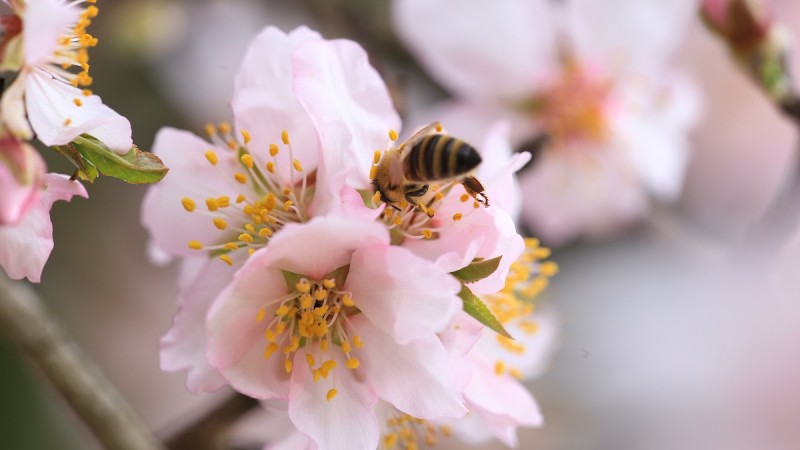Almonds: US exports to take a hit
April 11, 2025 at 12:34 PM ,
Der AUDITOR

Unwelcome trade war
Although US President Donald Trump paused the higher tariffs for nearly all countries he intended to target last week for three months, they remain at the top of the agenda for the almond industry, which will be particularly hit as California exports around 80% of production. A baseline tariff of 10% for imports from all countries, hoever, applies since 2 April. In addition, Trump has left a 125% tariff in place for imports from China and Beijing has retaliated with an 84% tariff for imports from the US. As the current US crop is nearly sold the tariffs will mainly impact the 2025/2026 crop as Olam has emphasised in the most recent update on almonds. With tensions escalating between China and the US in recent months, shipments to China have already taken a notable hit. The former main export destination only just ranks amongst the top ten.
US exports still holding up
At 221 million pounds monthly grand total shipments for March are in line with industry expectations with Olam predicting that shipments will not be able to keep up with last year as supplies are more limited. March shipments are, in fact, 7% off on last year’s 237 million pounds. Exports have thereby declined by 3% to 170 million pounds and domestic shipments have slumped by 17% to 52 million pounds.
Year-to-date shipments show a similar trend, although domestic shipments are a more modest 4% down at 466 million pounds. Exports are relatively flat on last year at 1.344 billion pounds and the grand total has dipped by 2% to 1.8 billion pounds. Trump’s proposed tariffs are impacting speculations in nearly all export destinations.
Shipments to India finally bounced back in March but still range 9% lower than last year. Trump intended to unleash a 24% import tariff on the country and negotiations are currently underway to establish a trade deal with Indian officials stressing that they are keen to turn away from China and approach the US.
While shipments to Spain and Germany have dipped, exports to other Western European destinations such as the Netherlands and Italy have risen this year. The EU has already decided on a 25% import tariff for certain US products including almonds after Trump slashed high tariffs on European steel and aluminium imports. While processors in Spain and other European countries are far from happy with this as the industry heavily relies on US imports to satisfy demand, organic producers in Spain see this as a chance to ensure fairer competition for locally grown nuts. While the markets initially reacted with relief to Trump’s decision to pause the 20% import tariff for EU products, the mood has again starting to change after French President Emmanuel Macron announced that the pause is fragile, and leading politicians insist the EU tech laws will remain in place. Negotiations with Trump will, in other words, be tense.
Exports to the United Arab Emirates have dipped by 3%. Yet, shipments to the Middle East as a region have gained this season so far with Turkey as the main driver. As news reports state the oil rich Gulf States are well positioned to weather Trump’s policies. Apart from the 10% baseline tariff Trump does not presently intend any punitive measures. Turkey’s government is also keen to exploit this situation. In calling on Chinese companies to set up production in Turkey, which will enable them to export to the US at much cheaper rates, President Recep Tayyip Erdoğan hopes to doubly profit. Yet, the EU is Turkey’s most important trading partner and if EU exports take a hit this will also impact Turkey’s spending power.
|
US almond shipments in 1,000 lbs |
|||
|
Destination |
2023/24 |
2024/25 |
Diff. |
|
India |
288,188 |
261,127 |
-9.4% |
|
Spain |
134,495 |
110,108 |
-18.1% |
|
UAE |
110,721 |
107,584 |
-2.8% |
|
Netherlands |
76,192 |
94,398 |
23.9% |
|
Turkey |
60,150 |
81,439 |
35.4% |
|
Italy |
59,655 |
63,125 |
5.8% |
|
Germany |
77,410 |
60,755 |
-21.5% |
|
Japan |
57,171 |
59,637 |
4.3% |
|
Morocco |
42,315 |
46,598 |
10.1% |
|
China/Hong Kong |
86,044 |
44,196 |
-48.6% |
|
Others |
364,015 |
415,197 |
14.1% |
|
Total Exports |
1,356,356 |
1,344,164 |
-0.9% |
|
Total Domestic |
482,488 |
465,540 |
-3.5% |
|
Grand Total |
1,838,844 |
1,809,704 |
-1.6% |
|
California almonds, 01/08-31/03 |
|||
Global production 23% up
According to the INC’s “Statistical Review” global production jumped by 23% to 1.8 million mt (3.9 billion pounds) in 2024/2025 as compared with 2022/2023. US production climbed by 15%. Yet, attention has turned to the new crop for which the bloom period was mixed. Main issues were poor bee health and differing reports throughout California. Expectation is that a bumper crop is out of the question and that production will range on a similar level as in the current season. The USDA’s Subjective Estimate will provide a clearer picture on 20 May. Good news, however, is that rain and snow filled up water reservoirs to around 96%. In some southern parts of the state water levels, however, range at 70%. Prices should remain firm for the remaining crop according to Olam.
Australia’s production bounced back by 39% to 153,550 mt (339 million pounds) in 2024/2025 and projections for 2025/2026 stand at 155,531 mt (343 million pounds), which is the second largest crop on record. The 2024/2025 export season, which came to a close on 28 February, was highly successful as the volumes shipped exceeded production for the second year in a row at 169,541 mt (374 million pounds). Trade agreements with China and India are taking effect and demand is on the rise in Southeast Asia, where Australian almonds are a viable alternative to US supplies. Production is expected to peak at 176,700 mt in 2027/2028 (390 million pounds) providing that growing conditions play along.
Production improved by 8% in Spain in the current season. Yet, prospects for the next crop are not exactly encouraging at present as March turned out to be the wettest since the 1960s. Trouble is that this may cause pests and fungi to spread. On the bright side it should, however, be noted that the rains helped to provide much needed water after last year’s severe drought. Reservoirs are 70% full in general, whereas water levels only range at 20% in southeastern Spain.
|
Global almond production, kernel basis (mt) |
|||
|
Country |
2023/24 |
2024/25 |
Diff. |
|
USA |
1,086,880 |
1,245,780 |
14.6% |
|
Australia |
110,707 |
153,550 |
38.7% |
|
Spain |
113,150 |
122,300 |
8.1% |
|
Turkey |
25,000 |
30,000 |
20.0% |
|
Portugal |
20,850 |
25,000 |
19.9% |
|
Italy |
21,800 |
21,000 |
-3.7% |
|
Morocco |
18,500 |
18,000 |
-2.7% |
|
China |
15,000 |
16,780 |
11.9% |
|
Tunisia |
12,000 |
12,000 |
0.0% |
|
Chile |
12,436 |
9,583 |
-23.0% |
|
Greece |
6,500 |
6,000 |
-7.7% |
|
Iran |
6,000 |
6,000 |
0.0% |
|
Others |
16,000 |
16,200 |
1.2% |
|
Total |
1,464,997 |
1,794,883 |
22.5% |
|
Almond Board of California, Almond Board of Australia, AEOFRUSE, Aegean Exporters Association, Portugal Nuts, Italian National Institute of Statistics, Chilean Almond Board, Greek Nuts & Fruits Trade Association and other INC sources |
|||
View more
- price chart, almonds, Mamra, Iran
- price chart, almonds, natural 13/14, Largueta
- price chart, almonds, blanched, 27/30, California SSR
- more price charts





